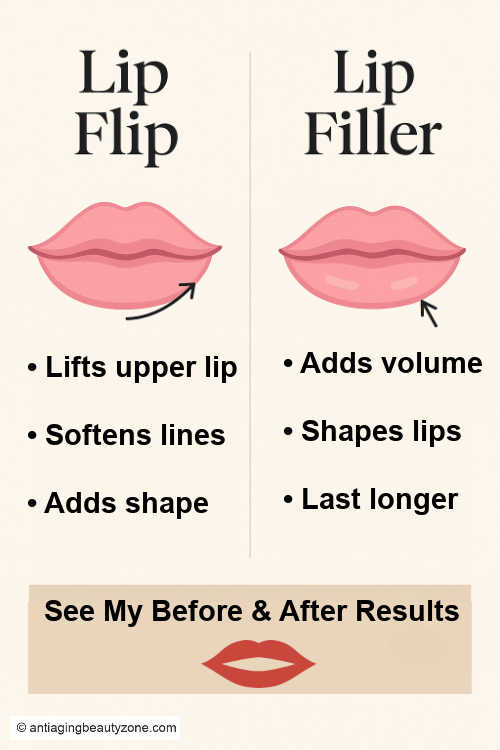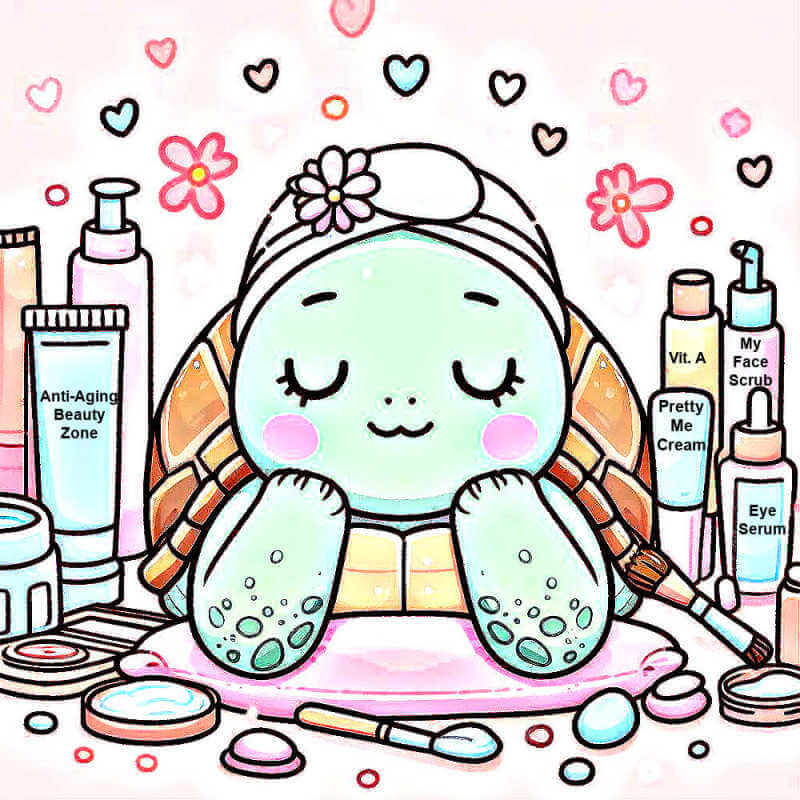As an Amazon Associate, I earn from qualifying purchases and other affiliate links. I only recommend products I’ve tried or researched.
Lip Injections vs Lip Fillers: What’s the Real Difference?
by: Linda Robison / Facial Fitness Specialist
What’s the difference between lip injections and lip fillers?
Lip injections vs lip fillers—are they the same thing, or totally different?
It’s one of the most common questions people have when considering lip enhancement. And it’s easy to see why—these terms get used interchangeably, but they don’t always mean the same thing.
Here’s the short version:
- Lip injections refer to the procedure (anything injected into your lips).
- Lip fillers are the substance being injected—usually hyaluronic acid to add volume and shape.
That said, some people use "lip injections" when they actually mean a Botox lip flip—which doesn’t add volume at all.
So if you're feeling confused, you're not alone.
Let’s break it all down clearly, so you can choose what works best for your lips, your goals, and your comfort level.

Are lip injections and lip fillers the same thing?
Technically, yes—but it depends on how the terms are being used.
Lip injections describe any cosmetic injection into the lips. That could include filler (to plump) or Botox (for a lip flip).
Lip fillers, on the other hand, always refer to injectable volumizers like Juvederm or Restylane.
So when people say “lip injection,” they usually mean filler—but not always. Read or ask carefully, especially if you're booking a consultation.
What do lip fillers actually do?
Lip fillers, also called dermal fillers, are a quick and easy way to enhance your mouth. They can be used to:
- add fullness
- create a poutier mouth
- enhance the shape of your lips
- define the cupid's bow
- smooth out lines or wrinkles
- correct a crooked or droopy mouth
The use of dermal fillers is regarded as safe, provided the injector has experience with cosmetic injections and lip augmentation treatment.
In fact, some studies show that lip fillers not only help improve your smile, but can help improve your self-confidence. Here are some benefits of lip fillers.
Wondering if lip filler stretches out your lips? Here’s what really happens over time.
What are the different types of lip fillers?

Here’s a quick breakdown of the most common brands—and what each one is typically used for:
Restylane vs. Juvederm
- Restylane: More granular and firm, which makes it better for structure and definition.
- Juvederm: Smoother and more hydrating, often used for a softer, plumper finish.
Juvederm Volbella XC, Voluma, and Ultra XC
These formulas retain more water, giving the lips a smooth, pillowy look. Great for overall volume.
Restylane Silk
Formulated for precision—ideal for small areas like the cupid’s bow or vermilion border. Also used around the mouth to soften fine lines.
Choosing the right lip filler for your needs
Choosing the right lip filler for your needs
The best filler for you depends on your lip shape, skin type (thin vs. thick), and the look you’re going for.
Ask yourself:
- Do I want fuller, plumper lips overall?
- Do I want to define the vermilion border to give my lips more shape without adding bulk?
- Do I want to enhance my cupid’s bow (just the upper lip)?
- Do I want to lift the corners of my mouth for a more upturned look?
Do injections hurt?

On a scale of 1 to 10? I’d say about a 6. 😬 But only for a second.
Here’s what really helps:
- A numbing cream is applied beforehand, though it only helps a little.
- Most lip fillers contain lidocaine, so once the first prick is over, it gets easier.
- The worst part is the needle going in at first.
Tips to reduce pain:
Personally, I think the first needle prick is the worst part. If you're getting multiple injections, ask your provider to switch to a fresh needle halfway through—dull needles can sting more.
Also, don’t hesitate to ask for:
- Their strongest numbing cream
- A plastic wrap cover over the cream (it helps it absorb better)
Everyone’s pain tolerance is different, so speak up if something feels uncomfortable. It’s your face—your comfort matters.
How long do lip filler last?
Usually 6–12 months. That varies based on:
- the type of filler
- how your body metabolizes it
- how often you get touch-ups
My experience: In my case, the results faded after about 6 months the first time. But after a few sessions, they started lasting closer to a year.
What are the side effects of lip fillers?
Common side effects include:
- Bruising
- Swelling
- Tenderness
- Cold sore reactivation (if you’re prone to them)
Rare but serious: vascular occlusion (a blocked blood vessel).
If your lips turn white, blue, or black—or you feel severe pain—call your injector immediately.
Who is a good candidate for lip fillers?
You’re likely a good fit if you:
- don’t smoke
- aren’t prone to cold sores (or take preventative meds like Valtrex)
- don’t have serious chronic conditions (like uncontrolled diabetes)
Can a Botox lip flip replace lip fillers?
Not quite—but it can be a great option if you're after subtle shape.
A lip flip involves injecting a small amount of Botox into the muscles just above the upper lip. This relaxes the muscle so the lip gently rolls outward, making it look fuller—without adding volume.
It’s perfect for:
- A more defined upper lip
- Less gum showing when you smile
- A subtle enhancement with no filler
👉 Want to know how many units of Botox are typically used?
Check my before and after pic of Botox lip flip.
Are there natural or longer-lasting alternatives to lip fillers?
Are there natural or longer-lasting alternatives to lip fillers?
Yes—if you're looking for something more permanent than HA-based fillers, here are a few options:
1. Fat grafting
This uses fat from your own body (usually from the stomach or thighs), which is purified and injected into your lips.
It’s considered semi-permanent—but keep in mind:
- Up to 50% of the fat may be reabsorbed
- It’s pricier than traditional filler
- There's more downtime than with lip injections
That’s why many providers prefer hyaluronic acid fillers like Juvederm or Restylane, especially in areas with lots of movement like the mouth.
2. Lip implants
This is a more permanent option that involves surgically placing small silicone implants into the lips through tiny incisions at the corners of the mouth.
- Adds volume to the upper, lower, or both lips
- Usually done under local anesthesia
- Minimal downtime, but recovery can take a few weeks
- Requires gentle eating, sleeping with head elevated, and avoiding pressure on the lips early on
💸 Cost: Typically ranges from $2,000 to $5,000
It’s a long-term solution—but it’s also more invasive, so make sure you consult a qualified facial surgeon if you're considering it.
Summary: lip injections vs lip fillers—what’s right for you?
Here’s the key takeaway:
- Lip injection = the procedure
- Lip filler = the product being injected
💉 If you’re new to lip enhancement, dermal fillers (like Juvederm or Restylane) are the most popular starting point. They’re fast, temporary, and reversible—perfect if you want to test things out.
The good news? Filler formulas are getting better every year—more natural-looking, longer-lasting, and easier to apply with minimal downtime.
Still deciding?
These pages might help:
- Do Fillers Stretch Out Lips?
- Lip Filler Benefits
- My Before & After Lip Flip for Thin Lips
- How Many Units of Botox for a Lip Flip?
FAQs
Q: Is a lip flip better than lip filler?
Q: Is a lip flip better than lip filler?
A: Not necessarily—it depends on what you want.
A lip flip uses Botox to relax the muscle just above your upper lip, so it gently rolls outward. It creates the illusion of a fuller lip without adding actual volume.
A lip filler adds volume by injecting hyaluronic acid directly into the lips. It’s better if you want a noticeable plump or reshaping.
Many people combine both for enhanced shape and fullness.
Q: How long do lip fillers really last the first time?
Q: How long do lip fillers really last the first time?
A: Most lip fillers last about 6 to 12 months—but first-timers often see results fade faster, around the 6-month mark. After a few touch-ups, they tend to last longer.
Q: Do lip fillers stretch out your lips?
Q: Do lip fillers stretch out your lips?
A: Not permanently.
While your lips may feel a bit “deflated” as the filler wears off, the skin usually bounces back. If you overfill repeatedly or too quickly, that’s when stretching can become more noticeable.
Q: What happens when lip filler wears off?
Q: What happens when lip filler wears off?
A: Your lips gradually return to their original shape.
You may notice a small change in texture or firmness for a bit, but hyaluronic acid fillers naturally dissolve and are absorbed by the body over time.
Q: Which looks more natural—lip flip or lip filler?
Q: Which looks more natural—lip flip or lip filler?
A: A lip flip is usually more subtle. It slightly lifts your upper lip and helps more of the pink part show when you smile.
Lip filler gives more volume and shape. Both can look natural—if done by a skilled injector.
Q: How painful are lip injections?
Q: How painful are lip injections?
A: On a scale of 1 to 10? Most people say around a 5 or 6, but only for a few seconds.
A numbing cream helps, and most fillers contain lidocaine to ease the sting. The first poke is usually the worst.
Pro tip: ask for a fresh needle halfway through—it makes a difference!
Q: What are the risks of lip fillers?
Q: What are the risks of lip fillers?
A: Most side effects are mild:
• Swelling
• Bruising
• Tenderness
• Cold sore flare-ups (if you're prone)
Rare but serious: vascular occlusion (when filler blocks a blood vessel). If your lips turn white, purple, or extremely painful, get medical help immediately.
Question: How much do lip fillers cost?
Question: How much do lip fillers cost?
Answer: Prices vary, but most lip filler treatments in 2025 range from $500–$800 per session depending on the brand, provider, and location.
About the Author:
Linda Robison is a Facial Fitness Specialist and the founder of Anti-Aging Beauty Zone. With decades of hands-on experience, she shares practical, natural ways to lift and brighten mature skin—without expensive or invasive treatments.
Before you go ....
Please tap on the💙in the bottom right corner if you found this page helpful.
FOLLOW ME FOR MORE TIPS:
SHARE OR SAVE FOR LATER:




